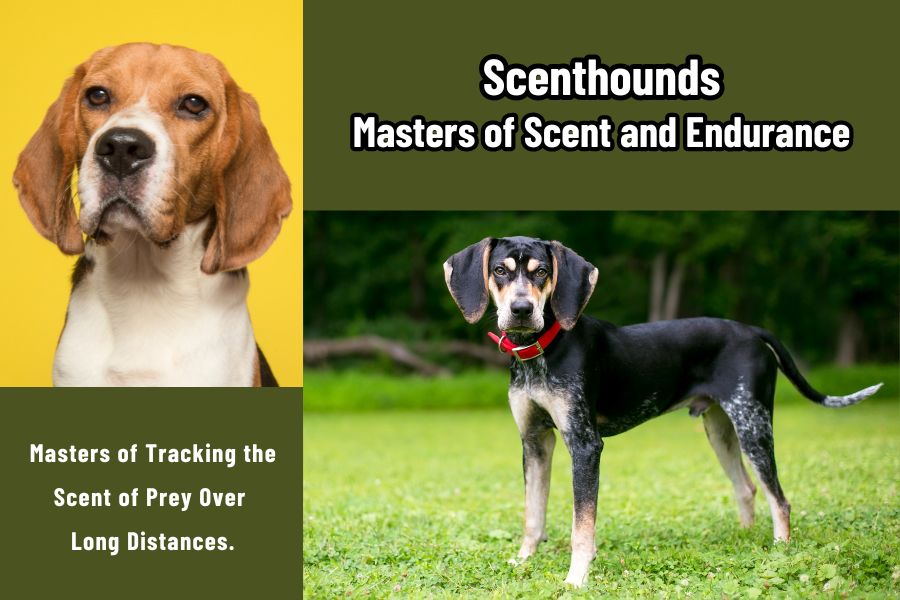Scenthounds are the ultimate trackers, known for their exceptional abilities to track prey over long distances. Discover their legendary history, high-endurance hunting skills, popular breeds, caring tips and why they make excellent hunting dogs. Let’s explore the world of scenthounds and find out how to unleash their full potential.
Introduction
Imagine a dog so in tune with its surroundings that it can follow a scent trail miles away, through dense forests and over rugged terrain. Scenthounds are extraordinary dogs, masters of scent and endurance, captivating hunters and enthusiasts for centuries.
Picture the ancestors of scenthounds, the large mastiff-type Roman warrior dogs. Later the Celtic people selectively bred these warrior dogs to track game. And eventually the early American settlers brought these trusted hounds to the New World.
These stories aren’t just history; they’re the foundation of modern hunting with scenthounds. Their evolution and enduring traits are a testament to their unmatched abilities in the field. Join us as we uncover the secrets of scenthounds.
The Legendary History of Scenthounds
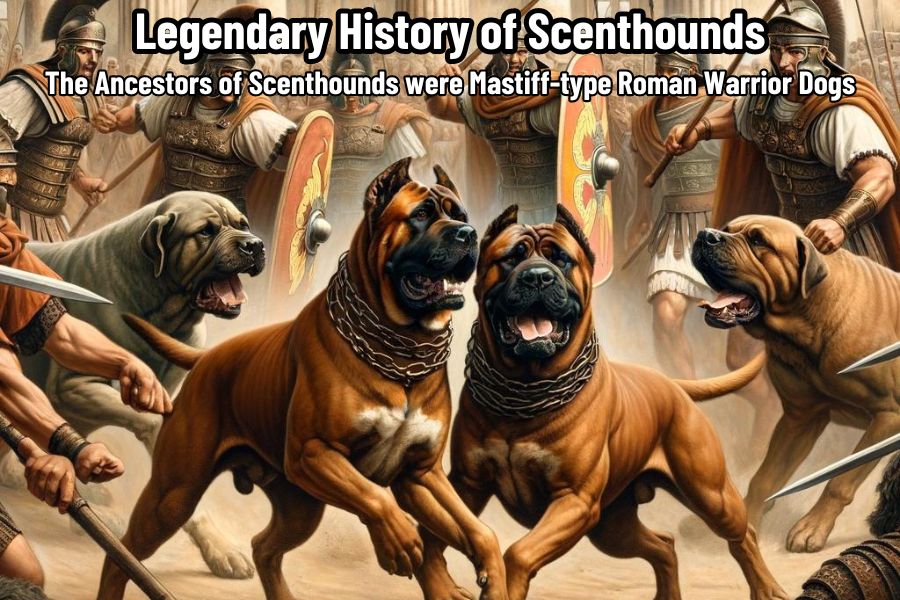
Scenthounds have a storied past, intertwining with human history in ways that highlight their invaluable role in hunting and companionship. From the battlefields of ancient Rome to the rugged landscapes of America, scenthounds have proven their worth time and again.
Warrior Dogs to the Celts’ Gigantic Scenthounds
The ancestors of modern scenthounds were early mastiff-type dogs, renowned for their strength and bravery. These dogs served as canine gladiators, fighting alongside Roman legions. However, the Celts saw a different potential in these powerful dogs. They noticed that some mastiffs possessed an extraordinary ability to track scents. The Celts began selectively breeding these mastiff-type dogs long before the Christian era, focusing on their scenting abilities. This selective breeding resulted in a new type of dog—gigantic scenthounds with lighter bones, less bulk, and a more manageable temperament. These dogs retained the mastiff’s iconic ears and thick skin but were faster, more enduring, and better suited for hunting.
Evolution of Scenthound Breeds
The refinement of scenthound breeds took a significant step forward during the Middle Ages in a Belgian monastery called St. Hubert’s. Here, monks dedicated themselves to perfecting these dogs, using Celtic dogs from Gaul, France. They developed the St. Hubert Hound, a medium-sized, black and tan dog with a heavy head and large bone structure. This breed became the progenitor of many future scenthound breeds. As these hounds spread across Europe, selective breeding continued, adapting the dogs to various climates, game, and terrains. This process ensured that each breed had the specialized traits needed for their specific hunting environments.
The American Scenthounds
The legacy of scenthounds crossed the Atlantic over a century before the American Revolution. Wealthy settlers brought with them English, Irish, and a few French hounds to the New World. These dogs laid the foundation for American scenthound breeds. The American foxhound, along with various raccoon hunting breeds—excluding the Plott—traces its lineage back to these early imports. These hounds quickly adapted to the diverse American landscapes, showcasing their versatility and enduring appeal.
Scenthounds in Action: The High Endurance Hunt
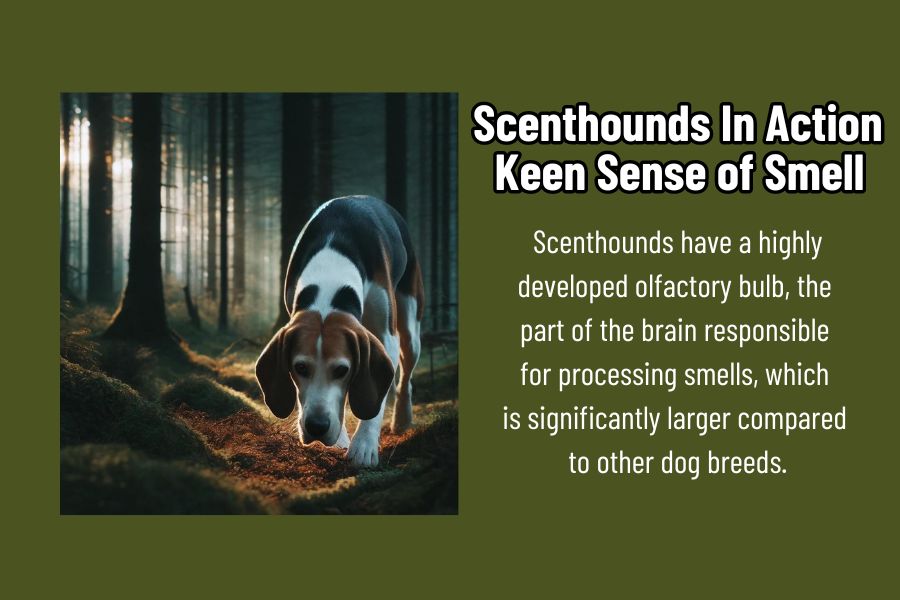
Scenthounds are the epitome of endurance and precision in the hunting world. Their remarkable abilities stem from centuries of selective breeding, resulting in dogs with an unparalleled sense of smell and stamina. Let’s delve into what makes these dogs the masters of scent and endurance in the hunting field.
Bred for Their Keen Sense of Smell
The exceptional scenting abilities of scenthounds are not accidental but rather the result of meticulous breeding focused on enhancing their olfactory prowess. These dogs have a highly developed olfactory bulb, the part of the brain responsible for processing smells, which is significantly larger compared to other dog breeds. This biological advantage allows scenthounds to detect and distinguish between a multitude of scents, even those that are several days old. For instance, a Bloodhound can follow a scent trail that is over a week old, showcasing the incredible sensitivity of their noses.
Masters of Tracking Prey Over Long Distances
Beyond their keen sense of smell, scenthounds are celebrated for their high endurance and relentless pursuit. Their strong physical structure is complemented by their instinctual drive to follow a trail to its end. Hunters have long relied on these scent trackers over vast distances, navigating challenging terrains without losing focus or tiring easily. Stories abound of scenthounds sticking to a trail for more than 100 miles, and never giving up on the pursuit.
Why Scenthounds Make Great Hunting Dogs?

Scenthounds are celebrated for their unparalleled hunting abilities, making them a top choice for hunters worldwide. Their unique combination of physical and behavioral traits, along with their versatility across various hunting scenarios make them among the best hunting hounds.
Physical and Behavioral Traits
Scenthounds possess several physical and behavioral traits that make them indispensable in the hunting world. Physically, these dogs are built for endurance and efficiency. They have strong, muscular legs that allow them to traverse long distances without tiring. Their deep chests accommodate larger lung capacity, enabling them to sustain prolonged activity. The loose, often wrinkled skin around their faces helps trap scent particles, enhancing their ability to follow trails.
Behaviorally, scenthounds are known for their exceptional focus and determination. Once on a scent, they are nearly impossible to distract, driven by an innate prey drive. Their high intelligence and trainability make them excellent partners in the field. Moreover, their friendly and loyal temperament ensures that they work well with their human handlers, responding to commands and adapting to various hunting strategies.
Advantages: The Versatile Hunters
One of the key advantages of scenthounds is their versatility. They excel in different hunting scenarios, whether it involves tracking small game or big game. Their ability to adapt to various terrains—from dense forests to open fields—makes them invaluable in diverse hunting environments. For example, a Beagle’s small size and agility make it perfect for navigating thick underbrush, while a Bloodhound’s powerful build and stamina are ideal for long pursuits over rugged terrain.
Popular Scenthound Breeds
Scenthounds come in various shapes and sizes, each with unique traits that make them exceptional hunters. In this section, we’ll explore ten popular scenthound breeds, delving into their origins, physical characteristics, and behavioral traits to understand what makes each one special.
Basset Hound: The Low-Slung Expert
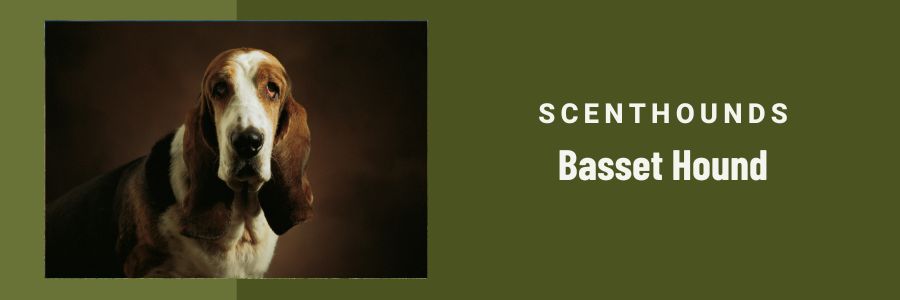
Origin and History
Basset Hounds originated in France, where they were bred for their ability to track game across rough terrain. Their name “Basset” comes from the French word “bas,” meaning “low,” referring to their short stature. Historically, they were favored by French aristocrats for hunting hare and rabbit.
Physical Traits
Basset Hounds are easily recognizable by their long ears, droopy eyes, and short legs. They typically stand between 11 to 15 inches tall and weigh around 40 to 65 pounds. Their coat is smooth and comes in various color combinations, including tri-color, red and white, and lemon and white. With an average lifespan of 10 to 12 years, they have a remarkable sense of smell, second only to the Bloodhound.
Behavioral Traits
Known for their gentle and laid-back nature, Basset Hounds have a strong prey drive and are quite tenacious when on a scent. They are versatile and can adapt to various hunting scenarios. These dogs are friendly, loyal, and good with families, though their stubbornness can make training a bit challenging. Their deep bark and howling can be endearing but also loud.
Beagle: The Rabbit Hunter’s Choice
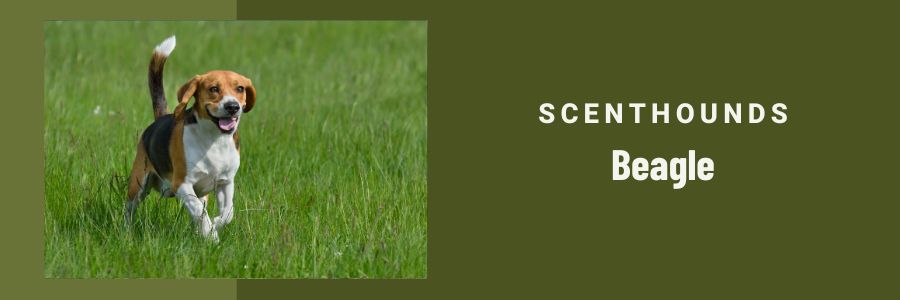
Origin and History
Beagles have a long history dating back to ancient Greece, but the breed we know today was developed in England. They were primarily used for hunting rabbits and hare, thanks to their incredible scenting abilities and agility.
Physical Traits
Beagles are small, muscular dogs, standing about 13 to 15 inches tall and weighing between 20 to 30 pounds. They have a short, dense coat that comes in various colors, commonly tricolor or lemon and white. Their keen sense of smell and tracking abilities are legendary, and they generally live 12 to 15 years.
Behavioral Traits
Beagles are known for their merry and curious disposition. They possess a high prey drive, making them excellent hunters. Athletic and versatile, Beagles excel in various environments. They are intelligent and trainable but can be stubborn. Their friendly and social nature makes them great family pets, though they need plenty of exercise to stay happy and healthy.
Bloodhound: The Legendary Tracker
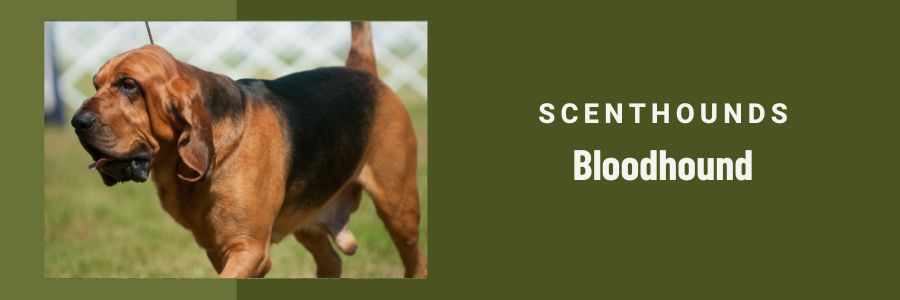
Origin and History
Bloodhounds are one of the oldest scenthound breeds, with roots tracing back to medieval France. They were originally bred by monks at the Saint-Hubert Monastery and were later refined in England. Bloodhounds were prized for their unparalleled tracking skills, especially for tracking humans.
Physical Traits
Bloodhounds are large dogs, standing 23 to 27 inches tall and weighing between 80 to 110 pounds. They have loose, wrinkled skin, long ears, and a distinctive, powerful build. Their coats are short and come in black and tan, liver and tan, or red. Bloodhounds have an incredible sense of smell, capable of tracking scents over long distances, and they typically live 10 to 12 years.
Behavioral Traits
Bloodhounds are gentle, affectionate, and determined. They have an extraordinary prey drive and are relentless when on a trail. Their intelligence and trainability make them excellent working dogs, though they can be quite independent. Bloodhounds are loyal and good with families, but their strong tracking instincts require regular mental and physical stimulation.
Bluetick Coonhound: The Relentless Pursuer
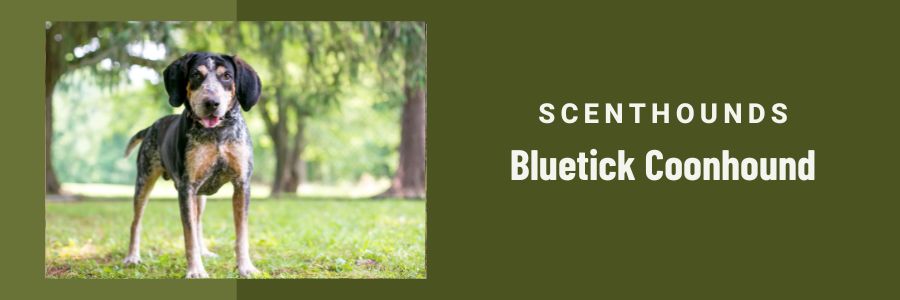
Origin and History
Bluetick Coonhounds originated in the United States, developed from various hound breeds brought over by early settlers. They were specifically bred for hunting raccoons and other small game, known for their cold-nosed tracking ability.
Physical Traits
Bluetick Coonhounds are medium to large dogs, standing 21 to 27 inches tall and weighing between 45 to 80 pounds. They have a sleek, muscular build with a distinctive blue-ticked coat and large, expressive eyes. Their keen sense of smell and stamina make them excellent trackers, with a lifespan of around 11 to 12 years.
Behavioral Traits
Bluetick Coonhounds are known for their relentless tracking ability and strong prey drive. They are athletic and versatile hunters, capable of covering rough terrain effortlessly. Friendly and loyal, they make good family pets, though their high energy levels require regular exercise. They are intelligent and trainable but can be independent and vocal.
Redbone Coonhound: The Small Game Hunter
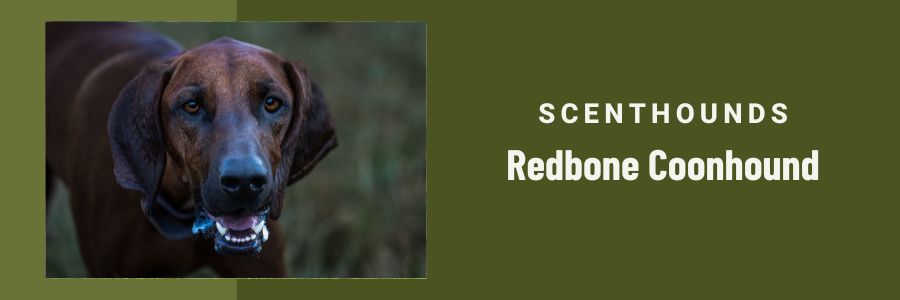
Origin and History
Redbone Coonhounds were developed in the southern United States, known for their striking red coats and excellent hunting abilities. They were primarily bred for hunting raccoons and other small game, with roots tracing back to red foxhounds brought by Scottish immigrants.
Physical Traits
Redbone Coonhounds are medium to large dogs, standing 21 to 27 inches tall and weighing between 45 to 70 pounds. They have a smooth, short reddish brown coat, a muscular build, and long, floppy ears. Their sharp senses and endurance make them formidable hunters, with a life expectancy of around 12 to 15 years.
Behavioral Traits
Redbone Coonhounds are known for their friendly and even-tempered nature. They have a strong prey drive and are highly versatile hunters, adapting well to different terrains. These dogs are loyal, trainable, and good with children, making them excellent family pets. Their high energy levels and vocal nature require regular exercise and engagement.
Black and Tan Coonhound: The Raccoon Hunter

Origin and History
The Black and Tan Coonhound was developed in the United States by crossing Bloodhounds with Black and Tan Virginia Foxhounds. This breed was specifically created for hunting raccoons, combining the Bloodhound’s scenting ability with the Foxhound’s agility and tenacity. Officially recognized by the American Kennel Club in 1945, Black and Tan Coonhounds have been a staple in American hunting culture.
Physical Traits
Black and Tan Coonhounds are large, powerful dogs, standing 23 to 27 inches tall and weighing between 65 to 110 pounds. They have a short, dense coat with a distinctive black and tan coloration. Their long, drooping ears and keen noses are perfect for scent tracking. Known for their endurance, these dogs can work tirelessly for hours. They typically live 10 to 12 years.
Behavioral Traits
Black and Tan Coonhounds are known for their strong prey drive and determination. They are athletic and versatile, capable of adapting to various hunting conditions. Their friendly and loyal nature makes them great family pets, although their independent streak can pose a challenge during training. With proper exercise and mental stimulation, they are affectionate and reliable companions.
Treeing Walker Coonhound: The People’s Choice
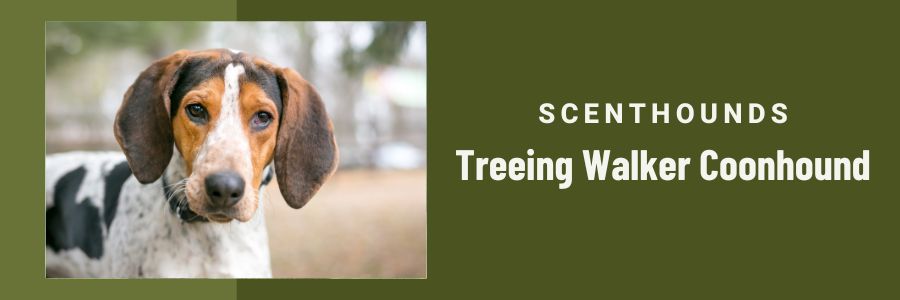
Origin and History
The Treeing Walker Coonhound originated in the United States, developed from the English Foxhound and other coonhounds. Named after Thomas Walker, who imported English Foxhounds to Virginia in 1742, this breed excels at “treeing” game, where they chase prey up into trees and alert hunters with their distinctive bark.
Physical Traits
Treeing Walker Coonhounds are medium to large dogs, standing 20 to 27 inches tall and weighing between 50 to 70 pounds. They have a smooth, short coat that comes in a tricolor pattern of white, black, and tan. These dogs are known for their speed, endurance, and keen sense of smell, with a lifespan of 12 to 13 years.
Behavioral Traits
Treeing Walker Coonhounds are highly energetic and driven by a strong prey drive. They are athletic and excel in various hunting environments. Their friendly and outgoing personality makes them “The Peoples Choice”, not only a great hunting dog but also an excellent family pet. They are intelligent, very trainable and are loyal companions. They do require plenty of exercise and mental stimulation and can be quite vocal.
English Foxhound: The Fox Hunter
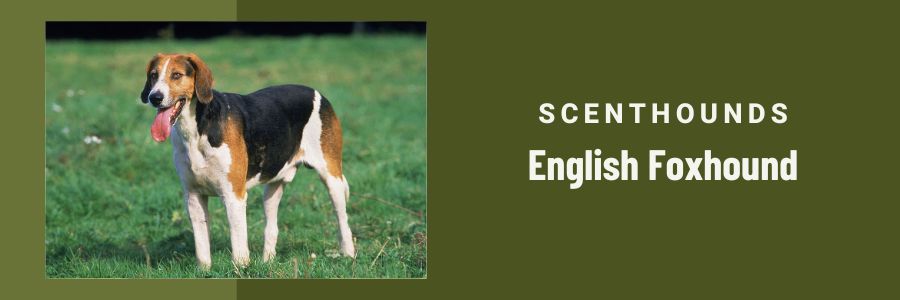
Origin and History
The English Foxhound has a rich history dating back to the 16th century in England, where they were bred for the sport of fox hunting. Developed from a mix of Greyhounds, Bulldogs, and Fox Terriers, they were designed for stamina and speed to keep up with horses and hunters.
Physical Traits
English Foxhounds are medium to large dogs, standing 24 to 27 inches tall and weighing between 65 to 75 pounds. They have a short, dense coat that is typically tricolor, featuring black, white, and tan markings. Known for their muscular build and endurance, these dogs can cover great distances. They generally live 10 to 13 years.
Behavioral Traits
English Foxhounds are known for their high energy levels and strong prey drive. They are athletic and excel in long-distance running and tracking. Their friendly and sociable nature makes them good family dogs, but their independent spirit can make training a bit challenging. They require regular exercise and mental stimulation to stay happy and healthy.
American Foxhound: The Rangy Hunter
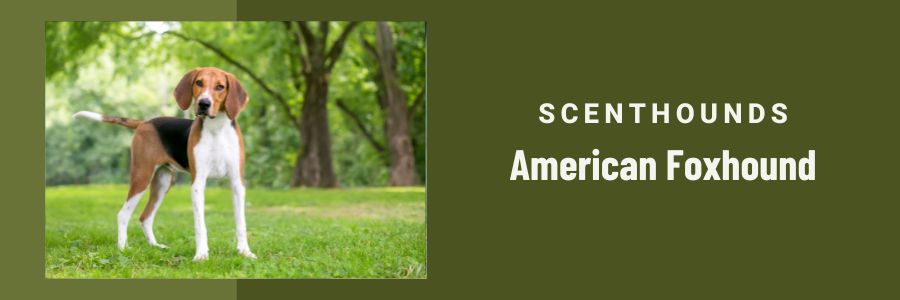
Origin and History
The American Foxhound was developed in the United States from English Foxhounds brought over by early settlers. George Washington, an avid fox hunter, played a significant role in refining the breed. American Foxhounds were bred for their speed and endurance to hunt foxes in the varied terrains of the American landscape.
Physical Traits
American Foxhounds are tall, lean dogs, standing 21 to 25 inches tall and weighing between 60 to 70 pounds. They have a short, hard coat that comes in various colors, commonly tricolor or bicolor. Known for their long legs and deep chest, these dogs are built for speed and stamina. They typically live 11 to 13 years.
Behavioral Traits
American Foxhounds are known for their strong prey drive and remarkable endurance. They are athletic and excel in tracking and hunting over long distances. Their friendly and gentle temperament makes them good family pets, although they can be quite independent and require consistent training. These dogs need plenty of exercise to maintain their physical and mental health.
Plott Hound: The Big Game Hunter
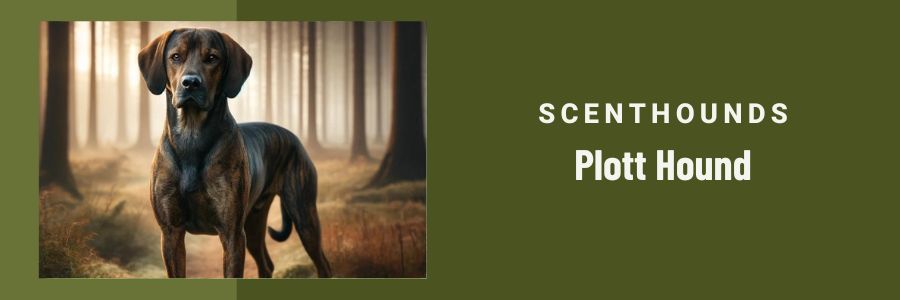
Origin and History
The Plott Hound is a unique American breed developed by the Plott family in North Carolina. This breed traces its roots back to German boar-hunting dogs brought to the United States in the mid-18th century. Plott Hounds were specifically bred for hunting wild boar and other big game, known for their toughness and tenacity.
Physical Traits
Plott Hounds are medium to large dogs, standing 20 to 25 inches tall and weighing between 40 to 60 pounds. They have a smooth, brindle coat that provides camouflage in the wilderness. With a strong, muscular build and long ears, these dogs are designed for endurance and strength. They have a lifespan of 12 to 14 years.
Behavioral Traits
Plott Hounds are known for their relentless pursuit and high prey drive, making them excellent big game hunters. They are athletic and versatile, able to navigate tough terrains with ease. Despite their fierce hunting capabilities, they are loyal and affectionate with their families. Intelligent and trainable, Plott Hounds require regular exercise and mental stimulation to stay content.
Other Popular Scenthound Breeds
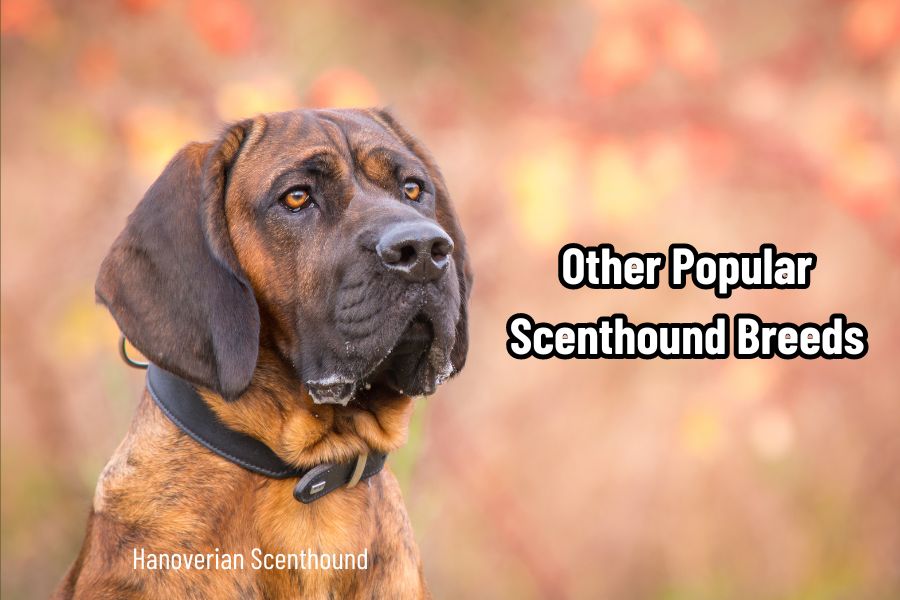
These scenthound breeds and more will be covered in future posts, providing detailed insights into their unique characteristics and hunting capabilities.
- Hanoverian Scenthound: Known for their excellent tracking and hunting abilities, descended from bloodhounds of medieval times.
- Dachshund: Known for their long bodies and short legs, Dachshunds are excellent for tracking and hunting small game like badgers.
- Grand Basset Griffon Vendeen: A French breed with a rough coat, known for its endurance and ability to hunt small game in challenging terrains.
- Petit Basset Griffon Vendéen: Smaller than its Grand counterpart, this lively and bold breed excels in hunting rabbits and other small game.
- Harrier: A medium-sized hound with a strong nose, Harriers are adept at tracking hares and foxes over long distances.
- Finnish Hound: Known for its versatility and endurance, the Finnish Hound is skilled at hunting various game in the harsh climates of Finland.
- Polish Hound: A robust breed with a keen sense of smell, Polish Hounds are traditionally used for hunting wild boar and deer.
- Catahoula Leopard Dog: Recognizable by their unique coat patterns, these dogs are excellent at tracking and herding game in diverse environments.
- Mountain Cur: Bred in the Appalachian Mountains, Mountain Curs are versatile hunters, known for their bravery and ability to hunt large game.
- Russian Hound: A versatile hunting dog used for tracking and flushing game, known for its endurance and keen sense of smell..
- Norwegian Elkhound: A sturdy breed with a thick coat, Norwegian Elkhounds are skilled at tracking and hunting moose in the Scandinavian wilderness.
- Otterhound: With a dense, waterproof coat and webbed feet, Otterhounds are exceptional swimmers, originally bred for hunting otters.
- American Leopard Hound: This versatile and intelligent breed is known for its tracking abilities and adaptability to various hunting tasks.
Caring for Scenthounds
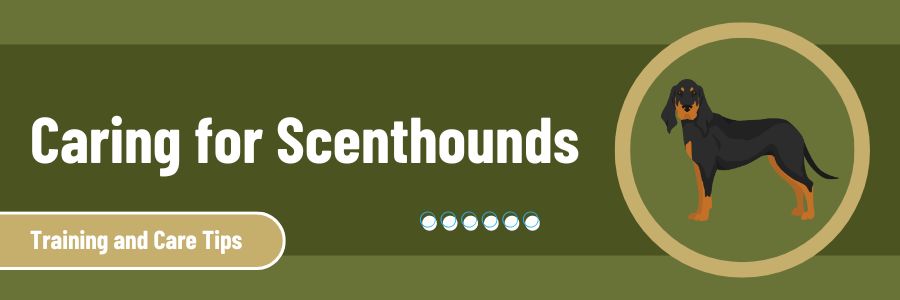
Proper training and care are essential for maintaining the health, happiness, and effectiveness of scenthounds. This section covers some key training tips, nutritional needs, healthcare recommendations, and bonding techniques.
Training Tips
Training scenthounds requires patience and consistency due to their strong-willed nature and high intelligence. Start with basic commands such as sit, stay, and come, using positive reinforcement methods like treats and praise. The basic commands must focus on establishing that you are in charge, not the dog. Advanced training should focus on honing their tracking skills. Incorporate scent trails and games that simulate hunting scenarios to keep their instincts sharp. Consistency is key, as scenthounds respond best to routine and repetition. Regular, short training sessions will help them retain commands and stay engaged without becoming bored.
Nutritional Tips
Scenthounds are athletic dogs with high energy levels, requiring a diet rich in protein and fats to sustain their endurance. Opt for high-quality dog food formulated for active breeds, which provides the necessary nutrients to keep their muscles strong and energy levels stable. Include lean meats, fish, and eggs for protein, and healthy fats from sources like fish oil and flaxseed. Avoid overfeeding to prevent obesity, which can be detrimental to their hunting performance and overall health. Always ensure they have access to fresh water, especially after vigorous activities.
Healthcare Tips
Regular health check-ups are crucial for scenthounds to manage breed-specific issues such as hip dysplasia, ear infections, and skin conditions. Due to their long ears, they are prone to ear infections, so it’s essential to clean their ears regularly and keep them dry. Regular dental care, including brushing and professional cleanings, helps prevent dental disease. Monitor their weight and physical condition to detect any signs of obesity or other health issues early. Vaccinations, flea and tick prevention, and regular deworming are also essential components of their healthcare routine.
Bonding Tips
Forging a strong bond with your scenthound enhances your partnership both during the hunt and at home. Spend quality time together through daily walks, play sessions, and training exercises. Engage in activities that stimulate their natural instincts, such as tracking games or hide-and-seek. Positive reinforcement and consistent communication build trust and loyalty. These scent tracking dogs thrive on routine and familiarity, so maintain a consistent schedule to help them feel secure and connected. Sharing these experiences not only strengthens your bond but also improves their obedience and responsiveness in the field.
Conclusion
Scenthounds are truly the masters of scent and endurance, making them invaluable companions for hunters. We explored their legendary history, high-endurance hunting skills, and the physical and behavioral traits that set them apart. We also delved into the specific capabilities of various breeds, highlighting their uniqueness. Additionally, we provided essential tips for training, nutrition, healthcare, and bonding.
Whether you’re a seasoned hunter or new to the world of hunting, these remarkable scent hunters have exceptional instincts, endurance and loyalty. Embrace the journey and uncover the incredible potential of scenthounds.
FAQs: Scenthounds
Below are answers to some common questions about sighthounds:
What is the difference between a sighthound and a scenthound?
Sighthounds and scenthounds are two distinct groups of hunting dogs. Sighthounds, such as Greyhounds and Whippets, rely primarily on their keen eyesight and speed to chase down prey in open terrain. In contrast, scenthounds depend on their exceptional sense of smell to track and locate game over long distances, often through dense cover or challenging environments.
What is Fair Chase Hunting with dogs?
Fair Chase Hunting is a principle that emphasizes ethical hunting practices, ensuring that animals have a fair chance to escape and are not subjected to undue stress or cruelty. When hunting with dogs, this means using trained scenthounds to track game naturally, without using unfair methods like trapping or baiting. This practice respects the skill of both the hunter and the hound while maintaining a balance with wildlife conservation.
Which scenthound has the best sense of smell?
The Bloodhound is widely regarded as having the best sense of smell among all scenthounds. Their olfactory capabilities are so advanced that they can track scents over several days and across great distances, making them invaluable in search and rescue operations as well as hunting.
Are scenthounds smart?
Yes, scenthounds are very intelligent dogs. Their intelligence is often reflected in their ability to solve problems and follow complex scent trails. However, their strong independent streak and focus on scent can sometimes make them seem stubborn or challenging to train compared to other breeds.
Which scenthound is best for hunting wild boar?
The Plott Hound is considered one of the best scenthounds for hunting wild boar. Known for their strength, courage, and relentless tracking ability, Plott Hounds are specifically bred to handle the aggression and size of wild boar, making them ideal for this challenging type of hunting.
Are scenthounds good family dogs?
Scenthounds can make excellent family dogs due to their friendly and loyal nature. They tend to be affectionate with family members and are generally good with children. However, potential disadvantages include their high energy levels, need for regular exercise, and strong prey drive, which can sometimes lead to stubbornness or difficulty in training. Proper training and socialization are key to ensuring they adapt well to family life. Some key pros and cons of Scenthounds as Family Dogs:
- Pros: Friendly, loyal, good with children, and protective.
- Cons: High energy levels, loud barkers and potential for stubbornness in training. Regular exercise and mental stimulation are necessary to keep them happy and healthy.
Resources: Scenthounds
These resources provide valuable insights into the world of scenthounds, offering both practical advice and fascinating historical context for enthusiasts and hunters alike.
SPECIAL NOTE: “The information provided in this post is based on Google research and the Resource links listed below. While we try to keep the information for this post current, there are no representations expressed or implied, about the completeness, or accuracy of the information provided. Therefore all hunters should always verify current information from these resources along with other local and federal publications”.
Online Resources
- AKC – American Kennel Club
- TKC – The Kennel Club
- UKC – United Kennel Club
- CKC – Canadian Kennel Club
Best Books
- “The Bloodhound: An Owner’s Guide to a Happy Healthy Pet” by Marcia Schlehr
- This book offers comprehensive information on the care, training, and history of Bloodhounds, renowned for their exceptional scenting abilities.
- “Beagle: A Comprehensive Guide to Owning and Caring for Your Dog” by Richard Roth
- An in-depth guide focused on Beagles, covering their history, training, and care, perfect for both novice and experienced owners.
- “The American Foxhound: A Complete and Reliable Handbook” by Robert W. Cole
- A detailed resource on the American Foxhound, exploring their origins, traits, and training needs.
- “Scent and the Scenting Dog” by William G. Syrotuck
- This book delves into the science of scent and the techniques for training scenting dogs, making it a valuable resource for anyone interested in understanding how scenthounds work.
- “Hounds of the World” by David Hancock
- A comprehensive guide to various hound breeds from around the globe, including detailed sections on scenthounds, their history, and their role in hunting.

